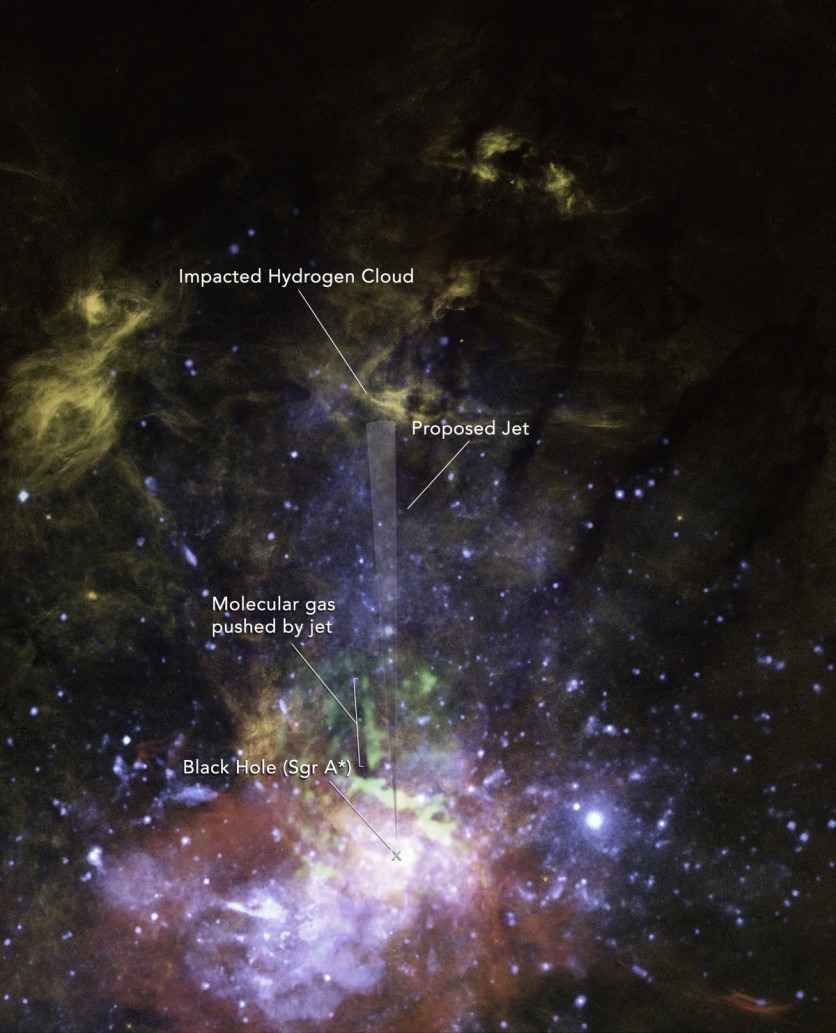The Hubble Space Telescope found a mini-jet from a thousand years ago plowing into gas near our Milky Way's supermassive central black hole.

Milky Way's supermassive black hole appears to have still remnants of a 'blowtorch-like jet' predated several thousand years ago. NASA's Hubble Space Telescope has yet to capture the alleged mini-jet in the black hole but assisted in finding circumstantial evidence that it is still plowing into a huge hydrogen cloud and then breaking apart.
NASA compared the situation of the mini-jet pushing into the hydrogen cloud similar to the 'narrow stream from a hose aimed into a pile of sand.'
This phenomenon is concrete evidence showing that the supermassive black hole, holding a mass of 4.1 million Suns, is not asleep but is only periodically hiccuping while gas clouds and stars fall into it.
How Do Black Holes Work?
As we know, whenever some material is drawn into a black hole, an accretion disk forms where some of the infalling material is sucked up into jets of outflowing material collimated by the black hole's magnetic fields. Then, a flood of dangerous ionizing radiation accompanies the narrow "searchlight beams."
In Chapel Hill's Gerald Cecil, the University of North Carolina pieced the puzzle together through multiwavelength observations coming from different space telescopes by suggesting that black holes emit mini-jets every time they swallow something heavy, like a gas cloud.
This observation is supported by evidence from 2013 when NASA's Chandra X-ray Observatory detected an elongated southern jet near the black hole, which appears to be plowing into gas too.
The Hubble Space Telescope and other telescopes have previously observed that the Milky Way galaxy's black hole had an outburst approximately 2-4 million years ago. In fact, it created a pair of enormous gamma-ray bubbles that tower above our galaxy.
First detected by NASA's Fermi Gamma-ray Space Telescope in 2010, the bubbles are surrounded by X-ray bubbles detected by the ROSAT satellite in 2003, which then was mapped fully by the eROSITA satellite in 2020.
In Hubble's ultraviolet-light spectra, the expansion velocity and structure of the ballooning lobes have been measured. The Hubble spectra have subsequently provided evidence that the burst was so powerful that it lit up a gaseous structure called the Magellanic Stream, about 200,000 light-years away from the galactic center. That said, the gas remains glowing until now.
Only a few decades after the Milky Way's black hole powers up again would the residual jet feature become more noticeable.
During such an outburst, Cecil notes, "the black hole would need to increase its luminosity by a hundredfold to fill the jet channel with emitting particles." Cecil also finds it fascinating to see how far the jet gets in that outburst.
Cecil added that for a jet to reach the Fermi gamma-ray bubbles, it would have to sustain itself for hundreds of thousands of years because they are each 50,000 light-years across.
The imagery of the black hole's shadow, projected by the Event Horizon Telescope, is expected to reveal where and how the jet is launched.
Related Article : Hubble Space Telescope Discoveries: Age of the Universe, Pluto's Two Moons, and More
This article is owned by Tech Times
Written by Thea Felicity
ⓒ 2025 TECHTIMES.com All rights reserved. Do not reproduce without permission.




